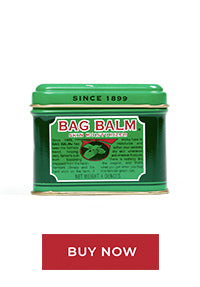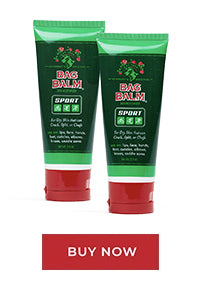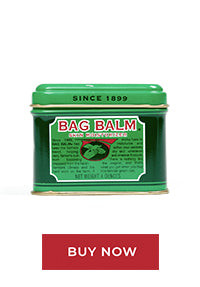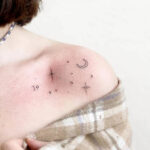Can I Use Bag Balm On My Tattoo? Yes, you can use Bag Balm on your tattoo, but with careful consideration. Bag Balm can be a good option for moisturizing and promoting healing, but it’s important to understand when and how to use it to avoid potential issues, and tattooat.com is here to help you navigate the best practices for tattoo aftercare to keep your ink vibrant and your skin healthy. Discover expert advice, artist recommendations, and stunning design ideas to ensure your tattoo journey is successful.
1. Understanding Bag Balm and Its Uses for Tattoos
1.1 What is Bag Balm?
Bag Balm is a lanolin-based ointment originally formulated to soothe irritation on cows’ udders. Its moisturizing and antiseptic properties have made it a popular choice for treating dry skin, minor cuts, and abrasions on humans as well. The formula typically includes lanolin, petrolatum, and antiseptic ingredients.
1.2 Key Ingredients and Their Benefits
- Lanolin: A natural emollient derived from sheep’s wool, lanolin helps to moisturize and soften the skin.
- Petrolatum: Also known as petroleum jelly, petrolatum acts as an occlusive agent, creating a protective barrier on the skin to prevent moisture loss.
- Antiseptics: These ingredients help to prevent infection by killing bacteria. Common antiseptics in Bag Balm include hydroxyquinoline sulfate.
1.3 How Bag Balm Works on Skin
Bag Balm works by creating a protective barrier on the skin’s surface, locking in moisture and preventing dryness. The antiseptic properties help to keep the area clean and free from infection. This combination can aid in the healing process of minor skin irritations, making it a potential option for tattoo aftercare.
1.4 The Appeal of Bag Balm for Tattoo Aftercare
Many people are drawn to Bag Balm for tattoo aftercare due to its occlusive and moisturizing properties. The ointment can help to keep the tattooed area hydrated, which is essential for proper healing. The antiseptic ingredients may also help to prevent infection, although it is crucial to use it correctly.
2. Tattoo Aftercare: The Basics
2.1 Initial Care After Getting a Tattoo
After getting a tattoo, your tattoo artist will apply a bandage or protective covering over the area. It’s important to follow their instructions carefully, typically involving leaving the bandage on for a specified period, usually a few hours to overnight.
2.2 Cleaning Your New Tattoo
Gently clean the tattoo with mild, fragrance-free soap and warm water. Pat the area dry with a clean paper towel. Avoid using harsh soaps or scrubbing the tattoo, as this can cause irritation and damage.
2.3 Moisturizing Your Tattoo
Apply a thin layer of tattoo-friendly moisturizer to keep the skin hydrated. Many artists recommend using products specifically designed for tattoo aftercare, but some people also consider options like Bag Balm.
2.4 Avoiding Irritants
During the healing process, avoid exposing your tattoo to direct sunlight, tight clothing, and harsh chemicals. These can irritate the skin and interfere with healing.
2.5 Common Aftercare Mistakes
Common mistakes include:
- Over-moisturizing
- Using harsh soaps
- Picking at scabs
- Exposing the tattoo to sunlight
- Soaking the tattoo in water
3. Can You Use Bag Balm on Your Tattoo?
3.1 The Short Answer
While some people have successfully used Bag Balm on their tattoos, it’s generally not the first choice recommended by tattoo artists. Here’s why.
3.2 Potential Benefits
- Moisturization: Bag Balm’s lanolin and petrolatum content can help keep the tattooed area moisturized, promoting faster healing.
- Protection: The ointment creates a barrier against external irritants and bacteria.
- Antiseptic Properties: The presence of antiseptics can help prevent infection.
3.3 Potential Risks
- Over-Moisturization: Bag Balm is quite thick and occlusive, which can lead to over-moisturization. Over-moisturizing can hinder the healing process and increase the risk of infection.
- Allergic Reactions: Some individuals may be allergic to lanolin or other ingredients in Bag Balm.
- Clogged Pores: The thick consistency can clog pores, potentially leading to breakouts or irritation.
- Not Specifically Formulated for Tattoos: Bag Balm is not designed for tattoo aftercare, and it lacks ingredients that specifically promote tattoo healing, such as those found in specialized tattoo lotions.
3.4 Expert Opinions
According to Inked Magazine, many tattoo artists advise against using Bag Balm due to its thickness and potential for causing issues like clogged pores. They typically recommend lighter, water-based lotions or tattoo-specific products.
3.5 When Bag Balm Might Be Considered
If you have very dry skin and are prone to cracking or severe dryness, Bag Balm might be considered in small amounts and for a limited time. However, it’s best to consult with your tattoo artist first.
4. How to Use Bag Balm Safely on a Tattoo
4.1 Consultation with Your Tattoo Artist
Before using Bag Balm, consult with your tattoo artist. They can assess your skin type and the specific needs of your tattoo to provide personalized advice.
4.2 Patch Test
Perform a patch test by applying a small amount of Bag Balm to an area of skin away from the tattoo. Wait 24-48 hours to see if any allergic reaction occurs, such as redness, itching, or swelling.
4.3 Application Technique
If you decide to use Bag Balm, apply a very thin layer to the tattoo. Gently rub it in until it is mostly absorbed. The goal is to moisturize the skin without creating a thick, suffocating barrier.
4.4 Frequency of Use
Limit the frequency of Bag Balm application to once or twice a day. Monitor the tattoo for any signs of over-moisturization, such as excessive shine or a build-up of product.
4.5 Duration of Use
Use Bag Balm for a limited time, such as a few days, and then switch to a lighter, tattoo-specific moisturizer. This helps to avoid potential issues associated with long-term use.
4.6 Monitoring Your Tattoo
Watch for any signs of irritation, infection, or allergic reaction. If you notice redness, swelling, pus, or excessive itching, discontinue use and consult with a healthcare professional.
5. Better Alternatives for Tattoo Aftercare
5.1 Tattoo-Specific Lotions and Balms
Tattoo-specific products are formulated with ingredients that promote healing, reduce inflammation, and protect the tattoo from fading. Look for products containing ingredients like:
- Panthenol: Helps to soothe and moisturize the skin.
- Vitamin E: An antioxidant that protects the skin from damage.
- Aloe Vera: Provides cooling and anti-inflammatory benefits.
- Shea Butter: A natural emollient that moisturizes and softens the skin.
5.2 Water-Based Lotions
Water-based lotions are lightweight and less likely to clog pores. They provide adequate hydration without the risk of over-moisturization.
5.3 Fragrance-Free and Alcohol-Free Products
Avoid products containing fragrances, alcohol, or other harsh chemicals, as these can irritate the skin and interfere with healing.
5.4 Recommended Products
Some popular tattoo aftercare products include:
- Aquaphor Healing Ointment: A gentle and effective option for moisturizing and protecting new tattoos.
- Hustle Butter Deluxe: A tattoo butter made with shea, mango, and aloe butters.
- Redemption Tattoo Aftercare: A lotion formulated with vitamins and natural ingredients.
- After Inked Tattoo Moisturizer: A vegan-friendly lotion that promotes healing and color vibrancy.
6. Understanding the Tattoo Healing Process
6.1 Stage 1: The First Few Days
In the first few days, the tattoo will be tender and may ooze a bit of ink, blood, and plasma. This is normal. Keep the area clean and moisturized.
6.2 Stage 2: Peeling and Itching
Around the end of the first week, the tattoo will begin to peel and may become itchy. Do not pick at the peeling skin, as this can damage the tattoo and increase the risk of infection.
6.3 Stage 3: Continued Care
Continue to moisturize the tattoo and protect it from sunlight. The healing process typically takes 2-4 weeks, but it can vary depending on the size and location of the tattoo.
6.4 How to Tell if Your Tattoo is Healing Properly
Signs of proper healing include:
- Gradual reduction in redness and swelling
- Minimal itching
- Peeling of thin layers of skin
- No signs of infection
6.5 Signs of Infection
Signs of a tattoo infection include:
- Excessive redness
- Swelling
- Pain
- Pus or drainage
- Fever
If you suspect your tattoo is infected, consult with a healthcare professional immediately.
7. Long-Term Tattoo Care
7.1 Protecting Your Tattoo from the Sun
Sun exposure can cause tattoos to fade over time. Always apply a high-SPF sunscreen to your tattoo when exposed to sunlight.
7.2 Moisturizing Regularly
Keep your tattoo moisturized to prevent the skin from drying out and the ink from fading.
7.3 Staying Hydrated
Drinking plenty of water helps to keep your skin hydrated from the inside out, which can benefit the appearance of your tattoo.
7.4 Avoiding Harsh Chemicals
Avoid exposing your tattoo to harsh chemicals, such as those found in cleaning products or swimming pools.
7.5 Choosing the Right Clothing
Wear loose-fitting clothing to avoid friction and irritation.
8. Debunking Common Tattoo Myths
8.1 Myth: Tattoos Don’t Need Sunscreen
Fact: Sunscreen is essential for protecting tattoos from fading.
8.2 Myth: You Can’t Swim After Getting a Tattoo
Fact: You should avoid soaking your tattoo in water until it is fully healed, but gentle cleaning is necessary.
8.3 Myth: All Tattoo Aftercare Products Are the Same
Fact: Different products have different ingredients and formulations, so it’s important to choose one that is appropriate for your skin type and tattoo.
8.4 Myth: You Should Pick at Scabs
Fact: Picking at scabs can damage the tattoo and increase the risk of infection.
8.5 Myth: Tattoos Don’t Fade
Fact: Tattoos can fade over time due to sun exposure and other factors, but proper care can help to minimize fading.
9. Finding Inspiration and the Right Artist on tattooat.com
9.1 Exploring Tattoo Designs
tattooat.com offers a wide range of tattoo designs to inspire your next piece. From traditional to modern styles, find the perfect design that reflects your personality.
9.2 Connecting with Tattoo Artists
Discover talented tattoo artists in your area through tattooat.com’s extensive directory. Read reviews, view portfolios, and connect with artists who specialize in your desired style. Portland, OR, known for its vibrant tattoo culture, has many exceptional artists to choose from.
9.3 Reading Artist Profiles
Learn about each artist’s experience, expertise, and approach to tattooing. Understanding their background helps you find an artist who aligns with your vision.
9.4 Booking Consultations
tattooat.com facilitates booking consultations with artists, ensuring you can discuss your ideas and concerns before getting inked.
9.5 Utilizing tattooat.com for Aftercare Advice
Access a wealth of aftercare advice and tips on tattooat.com to ensure your tattoo heals beautifully and remains vibrant for years to come.
10. Frequently Asked Questions (FAQs) About Using Bag Balm on Tattoos
10.1 Is Bag Balm safe to use on a new tattoo?
Bag Balm can be used on a new tattoo if applied sparingly and with caution. Due to its thick, occlusive nature, it is best to consult with your tattoo artist before use.
10.2 What are the benefits of using Bag Balm on tattoos?
The benefits include moisturizing the skin, creating a protective barrier, and preventing infection with its antiseptic properties.
10.3 What are the risks of using Bag Balm on tattoos?
The risks include over-moisturization, allergic reactions, clogged pores, and not being specifically formulated for tattoo aftercare.
10.4 How often should I apply Bag Balm to my tattoo?
If you decide to use Bag Balm, apply it very sparingly once or twice a day.
10.5 Can Bag Balm help with tattoo itching?
Bag Balm’s moisturizing properties may help relieve itching, but be cautious not to over-moisturize.
10.6 What should I do if I have an allergic reaction to Bag Balm?
Discontinue use immediately and consult with a healthcare professional.
10.7 Are there better alternatives to Bag Balm for tattoo aftercare?
Yes, tattoo-specific lotions, water-based lotions, and fragrance-free products are generally better options.
10.8 How long should I use Bag Balm on my tattoo?
Use Bag Balm for a limited time, such as a few days, and then switch to a lighter, tattoo-specific moisturizer.
10.9 Can I use Bag Balm on an old tattoo?
Yes, Bag Balm can be used on old tattoos for moisturizing, but be mindful of potential pore-clogging.
10.10 Where can I find more information about tattoo aftercare?
Visit tattooat.com for comprehensive guides, artist recommendations, and expert advice on tattoo aftercare.
Bag Balm can be a consideration for tattoo aftercare, but it requires careful use and consultation with your tattoo artist. Lighter, tattoo-specific lotions are generally recommended for optimal healing and vibrant ink. Remember, proper aftercare is essential for ensuring your tattoo remains a beautiful piece of art for years to come.
Ready to explore the world of tattoos? Visit tattooat.com to discover stunning designs, connect with talented artists, and access a wealth of information on tattoo aftercare. Start your tattoo journey with confidence and ensure your ink stays vibrant and beautiful.
Address: 1825 SW Broadway, Portland, OR 97201, United States. Phone: +1 (503) 725-3000. Website: tattooat.com.
 Bag Balm Skin Moisturizer
Bag Balm Skin Moisturizer Sport Tube Bag Balm
Sport Tube Bag Balm

